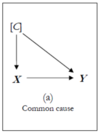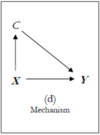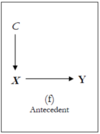Block 1: X-Centered RDs: Causal strategies: Beyond X and Y Flashcards
(29 cards)
Ross’ paper: “Is Democracy Good for the Poor”
– Measures child mortality as a proxy for welfare of the poorest
– Research wants to demonstrate causation: Democracy => Benefit to the poorest
– Based on co-variation
– Non-experimental/observational data
– Panel data research design
– Sample = population
Problem: Systematic bias with regards to missing observations (rich, autocratic states)
What is the fundamental problem of causation?
One uses a comparison of factuals to create information about counterfactuals
Refined definition of a confounder
Any factor that renders the co-variation of X and Y spurious, making evidence of causality difficult
Typology of confounders
Common incidents compound collisions with antecedent, exogenous mechanisms
Graph-based typology:
– common cause,
– incidental,
– compound treatment,
– collider,
– antecedent,
– endogenous,
– mechanism
Notation in causal graphs: C
C = Confounder that is measured and conditioned
Thus: Uncondition when found
Notation in causal graphs: [C]
[C] = Confounder that is unmeasured and unconditioned
Thus: Condition when found
Basic principles of conditioning

Typology of Confounders: Common Cause
Has a causal effect on both X and Y Solution: Condition on the common cause confounder, thereby breaking the link

Typology of Confounders: Incidental
Affects Y and is correlated with X, but not through any identifiable casual relationship

Typology of Confounders: Compound Treatment
Researcher fails to distinguish between a causal factor of theoretical interest and a confounder

Typology of Confounders: Mechanism
A conditioned factor is endogenous to X

Typology of Confounders: Collider
A conditioned factor is affected by both X and Y

Typology of Confounders: Antecedent
A conditioned factor affects Y only thorugh X Solution: Uncondition on Antecedent confounder

Typology of Confounders: Endogeneity
Situation where Y affects X

Typology of Confounders: Mechanism sub-types
1) Front-door 2) No front-door assumptions

Three general sorts of confounders
1) Pre-treatment confounders 2) Post-treatment confounders 3) Pre-/ post treatment confounders in longitudinal studies
Types of pre-treatment confounders
– assignment, –selection, – self-selection bias
List all the strategies of causal inference beyond X and Y
Instruments help condition mechanisms against rivals and alternative causal reasonings thus making them more causally heterogenuous and robus
– Conditioning on confounders
– Intrumental variables
– Mechanisms
– Alternate outcomes
– Causal heterogeneity
– Rival hypotheses
– Robustness tests
– Causal reasoning
Strategies of causal inference beyond X and Y: Conditioning on confounders
This approach conditions factors that would otherwise confound the relationship between X and Y

Strategies of causal inference beyond X and Y: Intrumental variables
A good instrument is a variable that: 1) is highly correlated with the treatment variable (X), and 2) has no effect on the outcome (Y) except through the treatment variable (X) (the exclusion restriction)

Strategies of causal inference beyond X and Y: Mechanisms and the assumptions thereof
Connection between X and Y that explains the covariational relationship
Front door approach assumptions:
– M is the only pathway between X and Y
– The components of M are isolated and measurable
– Any confounders (C) affecting X do not affect M

Strategies of causal inference beyond X and Y: Alternate outcomes
Focuses on variation across outcomes, instead of across groups or time.
- Placebo test*: Investigates alternative outcomes that a confounder should have affected, if an effect is noted the X-Y relationship is spurious
- Unconfounded outcome: T*ry and identify an alternative outcome (Y2), that correlates with Y1, but is free from confounders
- Within-unit:* Same group is divided into treatment and control sub-groups. Different outcomes, if independent, show the treatment effect

Strategies of causal inference beyond X and Y: Causal heterogeneity
When causal heterogeneity is not stochastic (random) the treatment effect can be measured through moderators (Z)
Assumption: The interaction between X and Z (X*Z) must not be influenced by confounders

Strategies of causal inference beyond X and Y: Rival hypotheses
As the name implies, strategy where instead of looking at X, the researcher looks at possible alternative causes (Z) of Y
Logic of elimination: If I cannot find any other explanation for variation in Y, there must be some truth in the X-Y link
Critique: By definition never conclusive


